Burned by a series of high-profile failures, the Air Force has overhauled its acquisition system. New rules and procedures are designed to produce better equipment over the long term, reduce delays and cost overruns, and restore the Air Force’s contracting credibility.
The new system will do little to speed up today’s glacial procurement process or fix troubled programs that are already well under way, however.
Air Force acquisition reached its darkest hour two years ago, when the KC-X tanker replacement program and “CSAR-X” rescue helicopter project both collapsed under prolonged contractor protests and litigation. The Government Accountability Office found that the Air Force wasn’t applying its own rules, and had been unclear or inconsistent in what it told its contractors. As delays or overruns on other big-ticket projects—satellites and aircraft upgrades in particular—piled up, it became obvious that a housecleaning was in order.
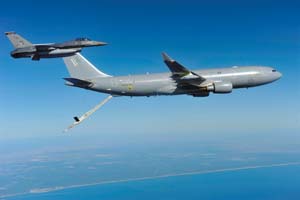 |
|
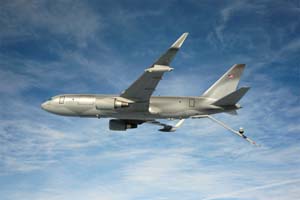 |
|
In 2009, USAF rolled out an acquisition improvement plan. It was “the fallout of assessments made following the KC-X source selection,” said Lt. Gen. Mark D. Shackelford, USAF’s top uniformed acquisition officer. The KC-X program was awarded to a Northrop Grumman-led team in 2008, but Boeing successfully appealed the decision, forcing the Defense Department to try again.
Now a year into its implementation, the acquisition improvement plan distilled 33 Center for Naval Analyses recommendations into five major initiatives. CNA was brought in to take an independent look at the Air Force’s procurement setup, and the initiatives deal with the overall problem of what Shackelford called “unmet expectations” in cost, performance, and schedule.
The first major test case for the new acquisition scheme was the Small Diameter Bomb II program, Shackelford said. Raytheon was selected to build the bomb in August, defeating a team of Boeing (which had developed the earlier version of the SDB) and Lockheed Martin. There were no protests of the Air Force’s choice.
“We should watch SDB II over the coming years and see how well it executes,” Shackelford said, because the new acquisition rules are in place early enough to make a difference. “Optimistically, they will execute very, very well, and we will get some validation that doing this type of expectation management and risk assessment prior to Milestone B is a fruitful way of getting there.”
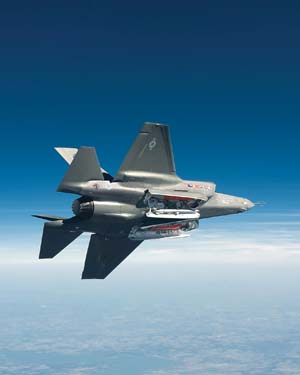 |
USAF leaders believe there’s still time to benefit from new acquisition policies on the F-35 fighter, shown in flight test. ( |
The new acquisition scheme adds many new requirements, obligations, and checks—layers of effort that would seem to slow the process down.
Lt. Gen. David A. Deptula, recently retired as deputy chief of staff for intelligence-surveillance-reconnaissance, said in August that he asked his staff how long it would take to field a new remotely piloted aircraft from scratch, if the requirements were well-understood today.
“And the answer was, around 2020 to 2021. Folks, we cannot afford that long a process in this era,” Deptula said. “We need to be able to operate much quicker, and inside our adversary’s decision loop.”
Shackelford concedes that “increasing velocity is going to be a challenge.” He said in large projects, the block approach, “taking somewhat smaller bites,” will help, but “it’s also a function of the processes that we have and the oversight” requirements. Some of those “are driven by statute, so they’re not easily changed,” and almost all are about reducing risk, which takes time.
Mark J. Lewis, former chief scientist of the Air Force, said that the imperative to drive down risk seems at odds with the idea of experimentation, “which is how you get to new things.”
Lewis said he’s worried that the acquisition culture has become so intolerant of an apparent failure that “you’re not allowed to try things out and sometimes have a failure, or intentionally have a failure and learn things from that, and move on.”
To that, Shackelford said it’s “a very valid observation” that there is an expectation of “success on the first try” in most programs, even experimental ones. Any failure has “some potential to generate a great deal of attention. That’s a sign of the times.”
However, he said, that there’s “room to go out and experiment” in the science and technology world, which wrings out potential systems long before they get to the point of transitioning to an operational system.
It’s a “hard sell” to industry, though, for the Air Force to get a contractor to invest in a demonstration that may not lead to an operational capability, production of which would justify the contractor’s investment.
Making the Case
Air Force Materiel Command is striving to make a closer connection between its science and technology funding and operational systems.
“It’s difficult to make the case for spending money on something that does not have a definitive purpose,” Shackelford admitted.
Even joint capability technology demonstrations, such as those that eventually led to the Global Hawk, Predator, and Reaper remotely piloted aircraft, “are being scrutinized very carefully right now because of the fear and trepidation of what it’s actually going to cost us when we have to go build those things for real.”
Despite the recent difficulties, however, Shackelford said USAF’s acquisition process was not “fundamentally broken.”
The Air Force “had two sustained protests in 2008 and we had one in 2009, and that’s out of, in each of those years, … something like 160,000 competitive transactions,” he said. “So our process works,” although some areas clearly still need attention.
The next two big tests of the revised acquisition system will be the KC-X, due to produce a winner in the fall, and the common vertical lift support platform, a descendant of the failed CSAR-X helicopter project. Both will put a spotlight on the Air Force’s efforts to bounce back from its acquisition troubles of the last decade.
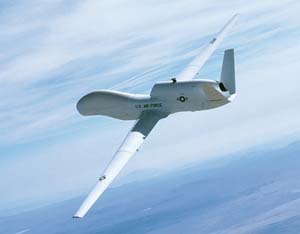 |
The RQ-4 Global Hawk (here, in test flight) started out as an experiment but has been improved steadily using the block upgrade approach. ( Northrop Grumman photo) |
The new processes take effect in a constrained environment. Shackelford sees “fewer new starts” in the near future, due to the constraints of flat budgets, and many of those will begin at “Milestone C”—commercially derived systems modified for military use.
The Pentagon would like to apply, whenever and wherever possible, fixed-price contracting methods to major acquisitions. Shackelford was asked how this will work in the KC-X, where both contractors are offering largely new designs based on existing aircraft.
Fixed-price contracting was tried with poor results in the 1980s, he noted. However, he said, “I would suggest to you that now the context is a bit different,” and the risk of the KC-X competition is well understood.
“We have a competent workforce that we are growing” and the right leadership is in place, Shackelford said. “Over the next one or two years, we should start to see improvements. Acquisition moves at a glacial pace, so it will take us a while to see very positive change.”
First among the five acquisition reform initiatives is “revitalizing the acquisition workforce,” said Shackelford. During the 1990s and early 2000s, the Air Force cut back on its procurement specialists, hoping that industry would fill the void in an effort to be efficient and provide best value products. It didn’t work out that way.
“We had hurt our workforce … and lost a lot of skills,” Shackelford said.
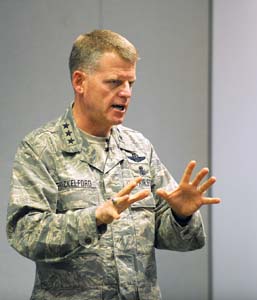 |
Lt. Gen. Mark Shackelford thinks there’s a place for fixed-price contracting when the product to be purchased is “well-understood.” ( USAF photo ) |
Now, the Air Force intends to hire about 7,000 people by about 2015 to bolster its acquisition corps. Many will be brought on as interns and journeymen, and then cultivated to become program managers and specialists in other fields.
“Those people are targeted to specific skills: program management, systems engineering, cost estimating, contracting,” Shackelford explained.
“We’re well down the path of hiring. We hired something over 2,000 people last year.”
Of the 7,000 people, 5,353 will be civilians.
Defense Secretary Robert M. Gates reached similar conclusions about Pentagon acquisition overall, and called for the hiring of some 20,000 additional procurement specialists, departmentwide.
“We had already been working on this for quite some time when he brought forth that decision,” Shackelford noted. “Of the 20,000 in his mandate, the Air Force share was 4,865,” so the service will exceed Gates’ directive by about 44 percent.
Beyond just bringing on the bodies, the Air Force is establishing skills courses to ensure that the new procurement specialists know what they’re doing—when they arrive, and as they advance.
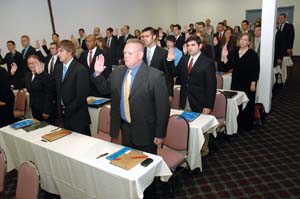 |
|
Retired Gen. Gregory S. Martin, former head of Air Force Materiel Command, said the Air Force should establish a career track wherein some acquisition specialists spend time in a variety of programs at various stages of progress, so that they can build skills in cost estimating, writing requests for proposals, negotiations, and related abilities.
“They would have to pass ‘check rides’ in each skill area,” Martin explained, so eventually, they would have built measurable abilities for every phase of an acquisition program, and have competence on program management, cradle to grave.
Such an approach is “in its infancy,” Shackelford said. AFMC is building a “competency tracking and measurement approach” that will document the experience that specialists acquire, so USAF can draw on their expertise when needed.
“At this point, what we’re doing is tracking and giving credit for involvement in the source selection,” Shackelford said. Previously, “we could not have gone to any database and told you who has that experience.”
The system is still being built, but it will be policy right from the beginning of the careers of the new hires.
The Block Approach
The second initiative has to do with requirements. Historically, programs have gone off the rails when requirements changed midprogram, requiring costly and time-consuming redesigns that broke budgets and ruined deployment timetables. The resulting headlines often caused Congress to heap a load of additional oversight and reporting mandates on such programs that only added complexity and cost.
As time went on, operators would demand more capabilities that would in turn begin the vicious circle anew.
” ‘Requirements creep’ is the traditional term,” Shackelford said.
The response, he said, has been to stabilize requirements. In earlier decades, it was said, a second lieutenant could add requirements to a program, but not even a four-star general could then get them deleted.
Now, “once we start the program, changing the requirements … invokes four-star” intervention, Shackelford noted. “We do as little [as possible] to perturb the program after you start it.”
But even before that, requirements changes will be headed off, first by insinuating acquisition pros into the requirements process early, to let operators know “the realm of the possible” and “avoiding ‘unobtainium, ’ ” Shackelford noted.
Requirements must also be certified as achievable, testable, and able to be produced by the workforce, he said.
Operators always want as much capability as possible right off the bat, but USAF has adopted a block upgrade approach. The goal is for the first iteration of a system to generally achieve 80 percent of the capability sought in the final requirement. Using block upgrades, it is possible to “freeze” a design for a given block—thus avoiding disruptive requirements changes—because further upgrades will come along in the next version.
“We have an obligation to go back” to the operator and explain which capabilities he wants “that are not mature enough or have too much risk to deliver in the first block,” said Shackelford. The cost of delivering the last percentages of desired performance can often add huge amounts to a program’s cost if these capabilities are demanded up-front.
The block approach also addresses the need to stay ahead of technology and insert new capabilities in an orderly way. Design freezes no longer mean that a system is consigned to obsolescence in 18 months when a new processor comes out.
Close cooperation between acquisition people and operators will ensure that “what we’re going to put on contract is what they actually want,” Shackelford said.
The third initiative is budget stability. Cutting a program’s budget even a small amount can force dramatic changes in the scope of work, schedule, and deliverables. Now, if the Air Force signs up for a program, the “corporate” process demands that the program be funded at the agreed levels.
The new system puts the Air Force’s acquisition executive into the top-most level of the budgeting process, too.
To further enhance budget stability, more stringent cost estimates will be made, and the Air Force will demand a higher level of confidence that a program is ready to proceed.
The fourth initiative has to do with the quality of the source selection process overall, and here, the Air Force had an object lesson in what not to do, in the form of the KC-X.
The new rules mandate that the Air Force will “execute the source selection exactly the way we said we would … in the request for proposal.” Rules and requirements will not be allowed to change midprocess, Shackelford noted, and there will be exhaustive documentation of every activity and action “at such a level that we are absolutely certain we can defend our decision if it’s challenged.”
Gates and his senior acquisition executives have said that when a winner is chosen in the rerun of the KC-X contest, they want the choice to be as protest-proof as possible.
Shackelford demurred when asked if this approach is simply intense rear-covering, preferring to describe it as being rigorous.
At least five times in a source selection, he said, an independent team of experts will “descend” on the enterprise to review its actions and correct any deficiencies they find.
Over time, he believes this approach will result in an embedded culture of quality and “due diligence” in the acquisition force.
Each of AFMC’s acquisition centers is “putting together a standing body of people from which they draw [to] do the source selection,” to ensure a high experience level.
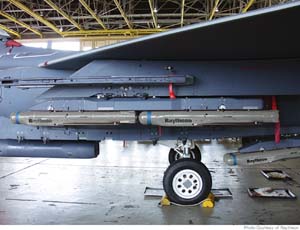 |
|
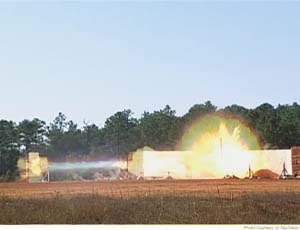 |
The Small Diameter Bomb Increment 2 (in test) was USAF’s first major contract award under the new acquisition policies. ( |
The fifth and last initiative has to do with “proper alignment” of authority and responsibility, Shackelford said. In programs that have done poorly, managers often did not have the authority to manage as they saw fit, sometimes forced to make changes dictated by people outside the process and unaware of all considerations.
The first step the Air Force took was to expand its program executive officers from six to 17. The PEOs have broad responsibility but also authority over their programs. Big projects such as the F-35 or the KC-X will have a single general officer as the PEO, but others will have a portfolio of programs under their jurisdiction. The ranks of the PEOs now include Senior Executive Service tier one officials and three colonels.
A Technological Suprise
At the same time, AFMC and Air Force Space Command acquisition organizations have been restructured. Six years ago, to make them more like the rest of the Air Force, the organizations were organized into wings, groups, and squadrons. Now, “we’ve reversed that and gone back to directorates, divisions, and branches,” Shackelford said.
Gen. Donald J. Hoffman, AFMC commander, has said the change was driven by the fact that the Air Force wing structure was ill-suited to the mostly civilian enterprise, and that in one case, due to the way responsibilities were divided, AFMC ended up with a one-person squadron.
The restructuring took away some organizational functions they “could stand not to have,” allowing units to focus strictly on their acquisition duties, Shackelford said.
The Weapons System Acquisition Reform Act of 2009 imposed some other obligations on the Air Force’s system, Shackelford noted. He pointed out that the law requires the Air Force to do competitive prototyping of a system before it can enter Milestone B.
“It doesn’t necessarily have to be a full-up weapon system,” he said, but the prototyping will serve to further reduce risk.
The law also echoes the Air Force’s own rules about programs not entering full-scale development until a preliminary design’s maturity had been established, “which is actually a very good idea,” he said.
Given that requirements will not be changed once a program or phase is under contract, what happens in the case of a technological surprise? What should the Air Force do if an adversary suddenly deploys a capability that can challenge a system in development
“It would really depend on what the details of the adversary change might be and what level of invasiveness it would be for us to change the system,” Shackelford noted.
“We’re trying to minimize … the government-directed changes, but realize sometimes we’re going to have to do that.”
For this reason, though, Shackelford said programs that are well-established probably will not benefit from the new acquisition scheme.
“It’s very difficult, because you’ve already got a contract mechanism in place” built on “a different set of philosophies,” he said. “And it’s prohibitive to crack open a contract midstream and make these kind of changes.”
For the future, though, Shackelford is optimistic the Air Force is recapturing its acquisition competency and ability to “do the job well.” If he is correct, the nation will benefit from better systems with more predictable costs.
